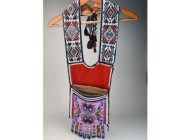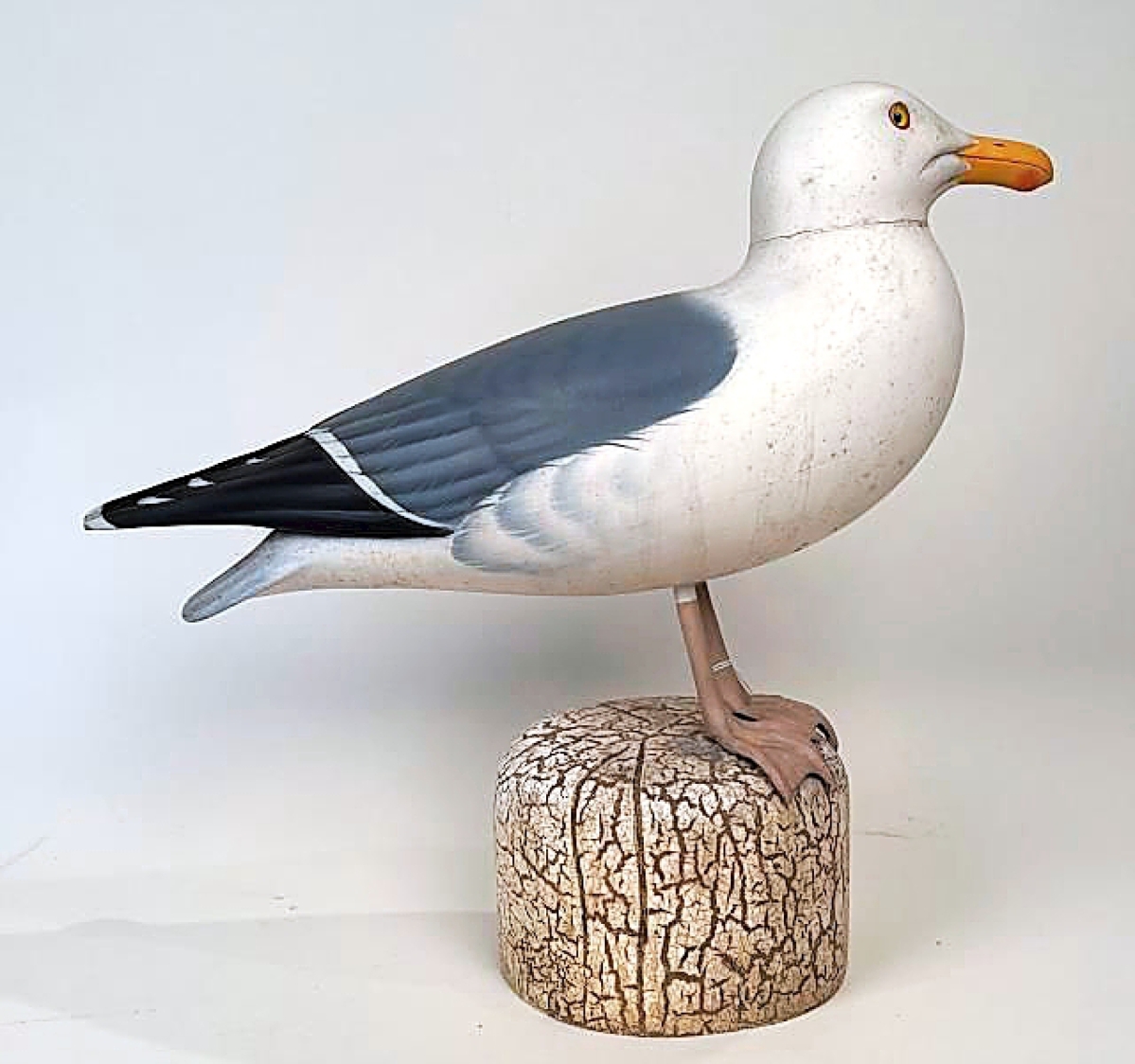
A signed 20-inch seagull carving by Keith Mueller, Meriden, Conn., sold for $369. The carving was originally sold unpainted in 1987 and was later returned to Mueller for painting.
Review by Rick Russack, Photos Courtesy Decoys Unlimited
WEST BARNSTABLE, MASS. – Ted Harmon, the founder of Decoys Unlimited, which he runs with his wife Judy, started collecting decoys at the age of 15 and conducted his first decoy auction more than 35 years ago, in 1986. His personal collection, which still includes one of those decoys from when he was 15, leans heavily to New England decoys and Elmer Crowell in particular. Harmon has been instrumental in establishing the A.E. Crowell American Bird Decoy Foundation, of which he is president, and the Crowell Barn Museum in Harwich, Mass.
His personal collection of Crowell decoys is well known to collectors. Given his interest, it’s not surprising that this sale included more than two dozen carvings by Crowell – miniatures, decoratives and working decoys. There were also numerous decoys by other New England makers, eight Mason factory decoys as well as examples of other factory decoys and an assortment of fish plaques and carvings. Harmon’s sales will often include sporting art and folk art, as did this one, and there was even an early Nineteenth Century mirror. Harmon did not plan a “blockbuster” sale, instead intending to offer a group of carefully selected, quality carvings affordable to all collectors. The online catalog descriptions were thorough, including multiple photos of items offered.
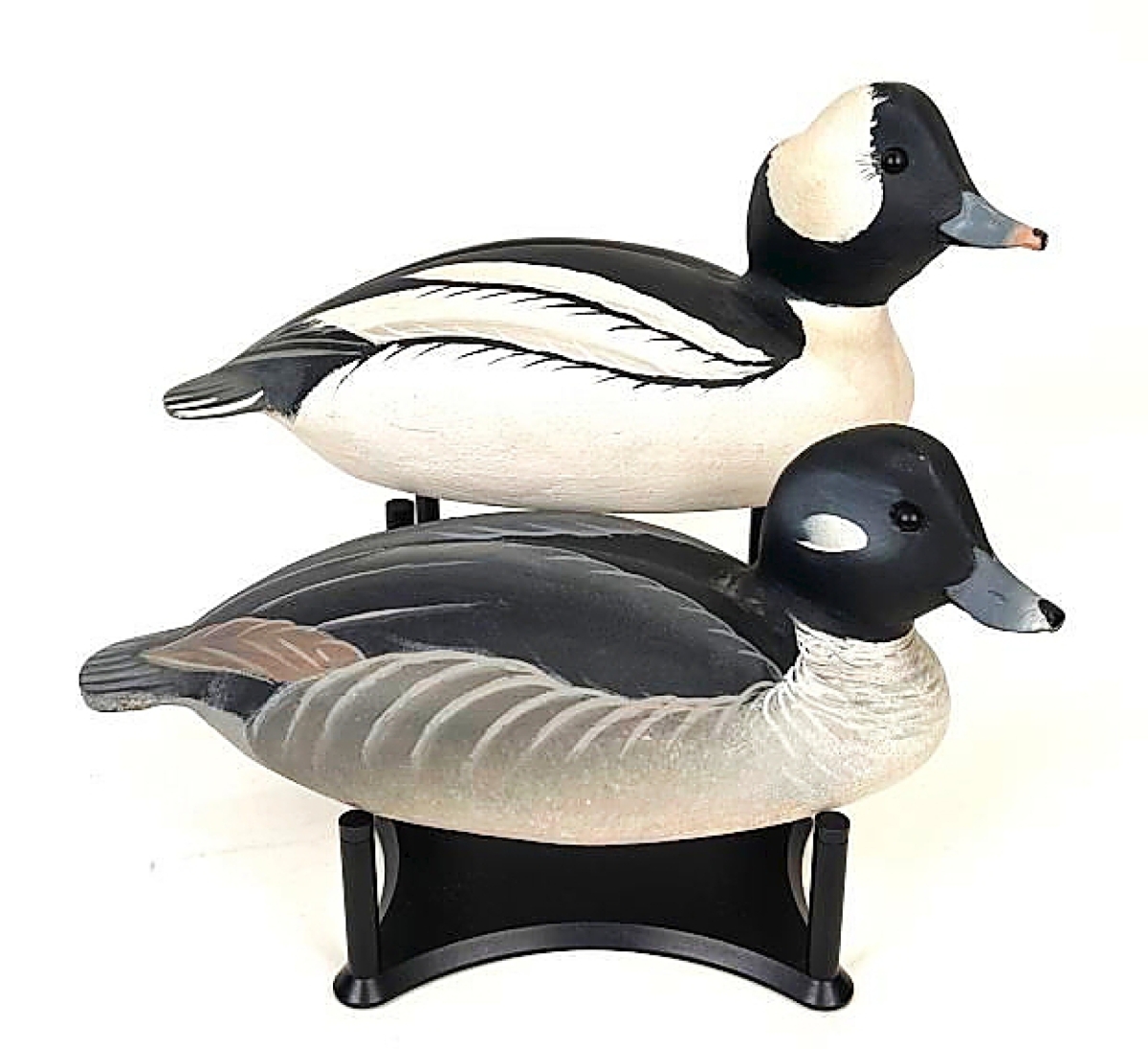
The bufflehead hen was 11 inches long and the drake was 12 inches long. They were made by the Ward Brothers of Crisfield, Md., and brought $4,920. They were signed on the bottom “Made by Steve, Painted by Lem, Ward Bro. -1966-” They also wrote their customer’s name “Dr Kramer” on the bases. The heads were slightly turned, and the bills had detailed carving.
Three of the five top prices were paid for carvings by Elmer Crowell (1862-1952). Most sought-after was a decorative “mantel” carving of a black-bellied plover, which sold for $36,000. It was about 10 inches tall with exceptional painting and standing on a carved and signed base. It had a slightly turned head, raised wingtips and metal legs. In all, there were more than two dozen Crowell carvings in the sale.
Some were early examples, circa 1890s, before he started marking his work, which began in 1912. An example of the early work was a working pair of bluebill decoys that had come from the rig of Dr Lombard C. Jones of Sandwich, Mass., a wealthy resident of the area. Jones was a Harvard graduate and long-time patron of Crowell. This pair was recently on exhibit at the Sandwich Glass Museum as part of an exhibit of items belonging to the Jones family. The pair sold for $7,688.
A 22 ½-inch Canada goose decoy made by Crowell for the Pequaw Honk Club earned $3,075. That was a shooting club located on Quicksand Pond in Little Compton, R.I. Crowell was known to have hunted there, most likely over his own decoys. Harmon described it thusly, “This is one of the best surviving Crowell geese decoys that was used at the club.” An early circa 1910 flying Canada goose with the same provenance sold for $5,535. (Russ Goldberger, RJG Antiques, has an extensive discussion of Crowell on his website, https://www.rjgantiques.com/article_1987_crowell.aspx)
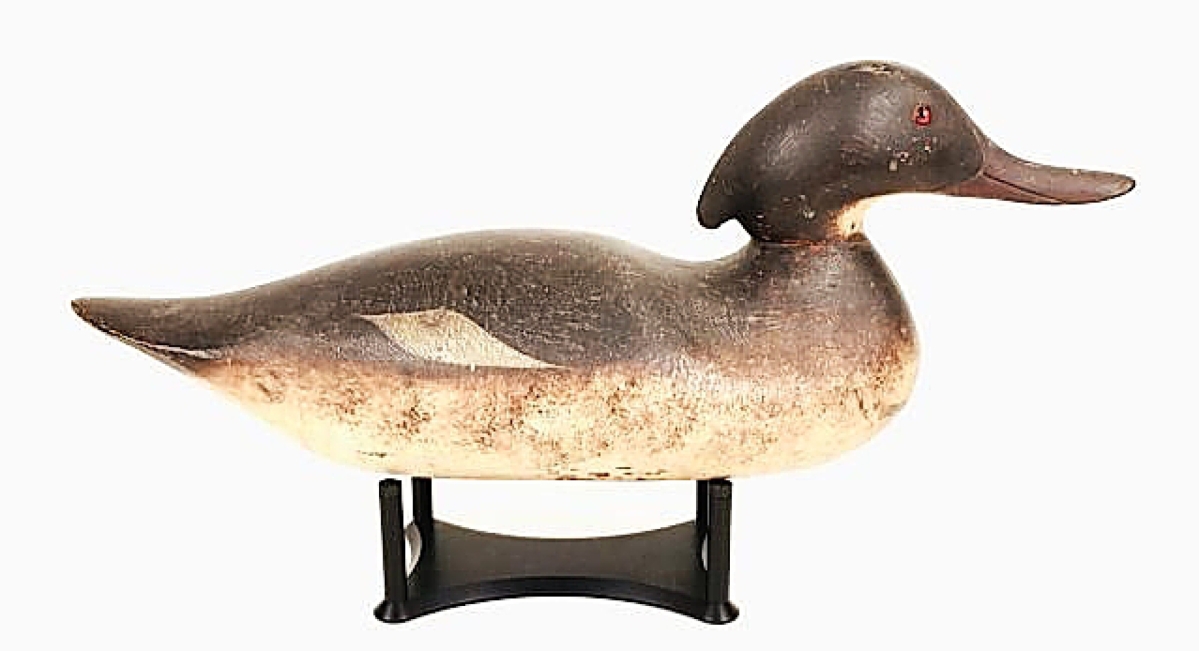
Mason Factory decoys included a 17¼-inch challenge grade Merganser hen, which finished at $4,920. The eyes were glass, it had an incised bill and original paint with only minor gunning wear.
Shorebird decoys by New England makers were well represented. One, by an unidentified maker, an 11-inch plover found on Chappaquiddick Island brought $738. Also from Chappaquiddick, a yellowlegs, also by an unidentified maker, brought $615, and a decorative life-size yellowlegs by Martin Collins, a contemporary Cape Cod carver born in 1960, brought $492. Two miniature yellowlegs, just 3½ inches tall, by Stan Sparre (1922-2011), East Falmouth, Mass., realized $246. There were more than 20 carvings in the sale by Sparre, including a preening yellowlegs that made $277.
Other New England birds included a rare full size brant by George Boyd (1873-1941) of Seabrook, N.H., which brought $5,843. When this decoy first came into the marketplace at a Richard Bourne auction several years ago, it was thought to be by Crowell. Harmon remarked, “We know so much more today than we did back in those days. So much research has been done.” Also by Boyd, a pair of miniature wood ducks, only 4 inches long, sold for $1,476. An unsigned 19-inch self-bailing brant by Joe Lincoln (1859-1938) of Accord, Mass., sold for $1,045. It was hollowed out with an open back, had glass eyes and incised bill detail. An unsigned red-breasted merganser from Maine in an uncommon “looking up” pose seemed like a good buy, bringing $338.
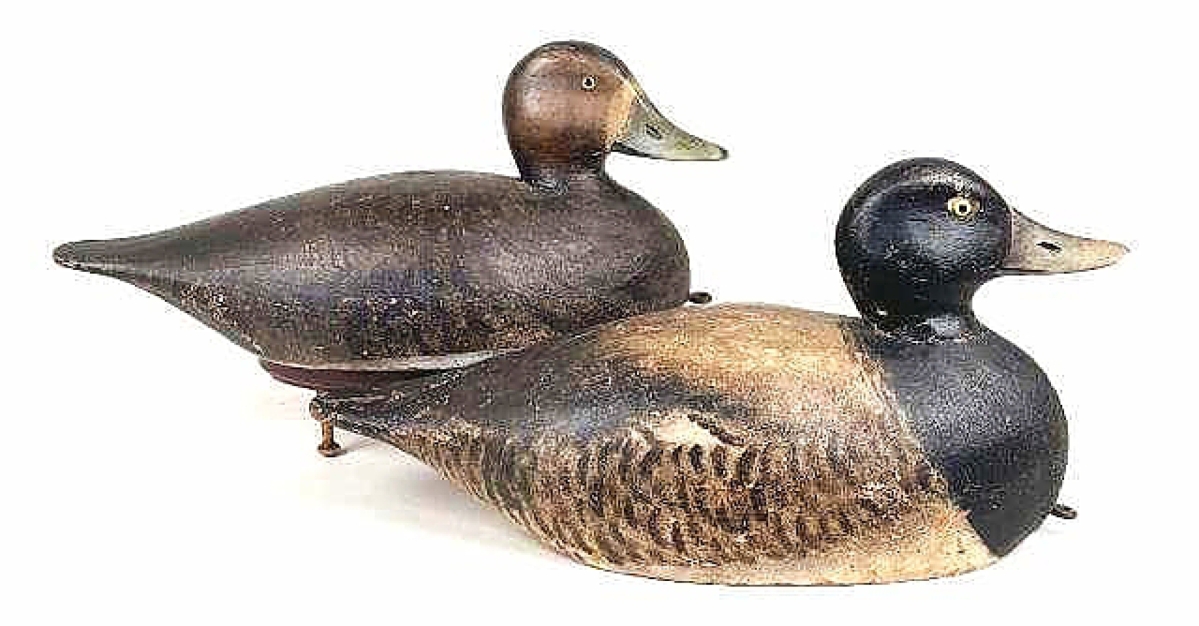
This pair of bluebill decoys by Elmer Crowell were from the hunting rig of Dr L.C. Jones of Sandwich, Mass. He was a long-time patron and friend of Crowell, and this pair was made about 1900, before Crowell started to mark his work. The lot finished at $7,688.
When Ted Harmon was asked before the sale which were his personal favorites, one that he picked was an unsigned, humpback eider drake from Maine that sold for $338. The sale included about a dozen eiders and it’s easy to see why someone would collect them. They tend to be among the “folky” decoys, usually simply painted black and white, the natural colors of the birds. They inhabit northern waters, often off the Maine coast, and many were made by local hunters in that area, often simply for their own use. The decoys had to be rugged, given the rough coastal waters. That means there can be a lot of variation in these decoys, as was shown by the selection in this sale. No two were alike and they also tend to be inexpensive, again as were the selections offered in this sale. Only one in this sale earned more than $500.
Along with Elmer Crowell carvings, decoys made by the Mason Decoy factory are among the most widely collected decoys. There were three grades: standard, challenge and premier, with the amount of detail increasing from grade to grade and the prices increasing accordingly. Mason decoys were turned on a lathe and finished by hand.
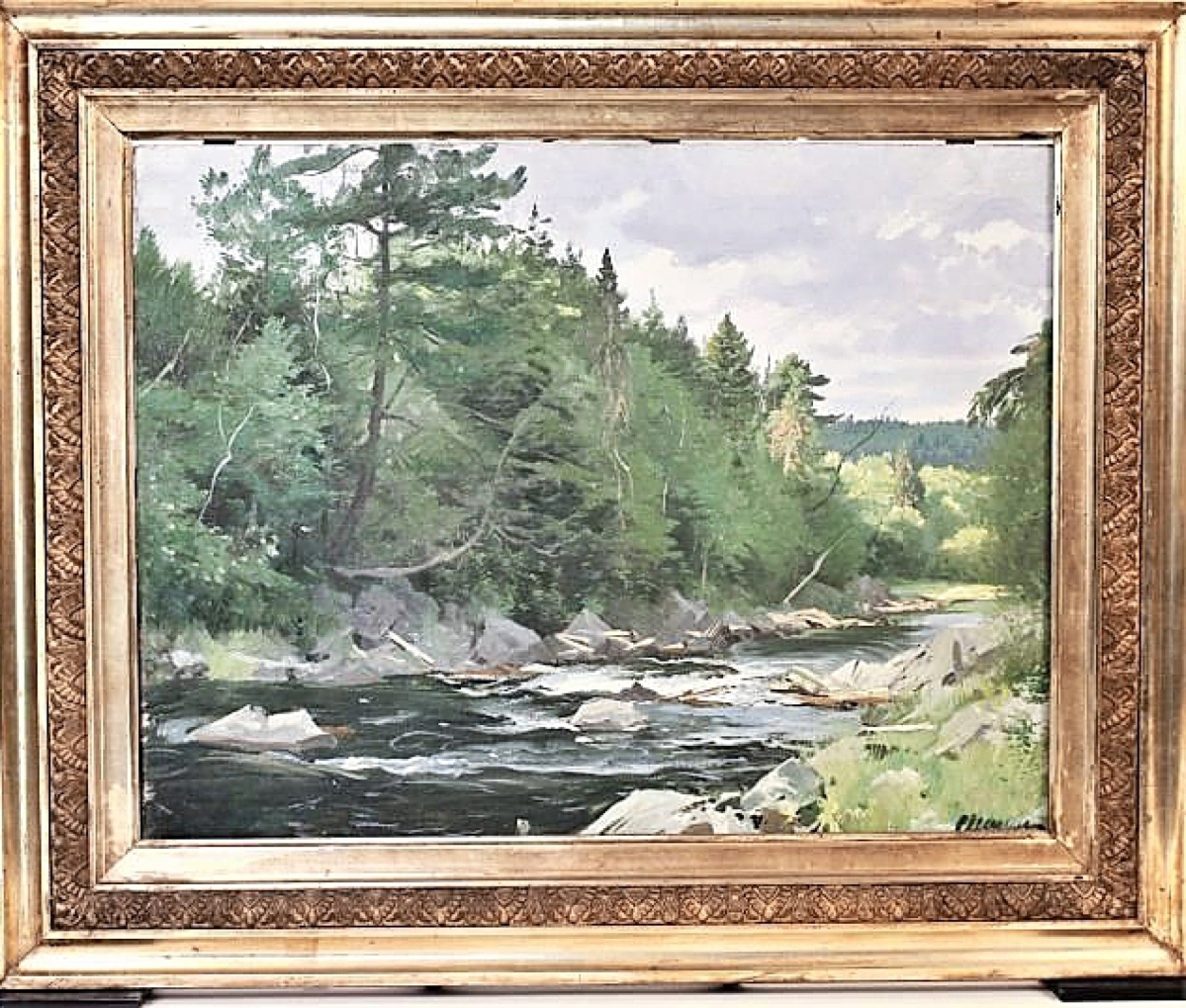
The sale’s second highest price, $8,303, was earned by an Ogden M. Pleissner (1905-1983) oil on board titled “Canadian Salmon Stream.” The painting was signed; the title was shown on an old gallery label.
Included in this sale was a 17¼-inch challenge grade Merganser hen, which finished at $4,920. It had glass eyes, an incised bill and original paint with only minor gunning wear. A premier grade blue-winged teal decoy with some condition issues sold for $2,768. A standard grade black duck, apparently never used, sold for $984. Folk art offerings included five weathervanes, most, unsurprisingly, had a nautical motif. A 38-inch three-masted schooner weathervane with metal sails and wire rigging by Frank Adams (1871-1944), West Tisbury, Mass., sold for $584, and a two-masted fishing schooner by the same maker sold for $461. A full-bodied copper eagle, 37 inches wide with restored directionals, seemed quite reasonable at $369.
There were numerous miniatures by Elmer Crowell and others. The highest price paid, $3,383, for a Crowell miniature was earned by white-winged Scoter hen, which was just under 5 inches tall. Prices for other Crowell miniatures ranged from $738 to $2,583. One of the more unusual offerings was a loon hen with two nestlings on its back by Stan Sparre, which brought $369. There were more than 20 carvings by Sparre, all selling above or within estimates. His bobwhite quail brought $431, and his turkey vulture, not usually a subject for miniature makers, brought $154.
After the sale, Harmon commented, “We did fine. It was an auction, and like any auction, some things did better than we thought they would and some didn’t. I think probably the best buys in the sale were the eiders. They were good examples but didn’t bring much money. Crowell’s wall-mounted goose, which finished at nearly $4,500, did well as did the factory birds. One factory bird in particular, a shoveler drake, brought $1,353, far more than we thought it would. It’s not a common species and apparently buyers knew that. We finished just below $175,000 and we’re still selling some of the items that were passed, so it looks like we’ll get to that number.”
Prices given include the buyer’s premium as stated by the auction house. For information, www.decoysunlimitedinc.net or 508-362-2766.



























